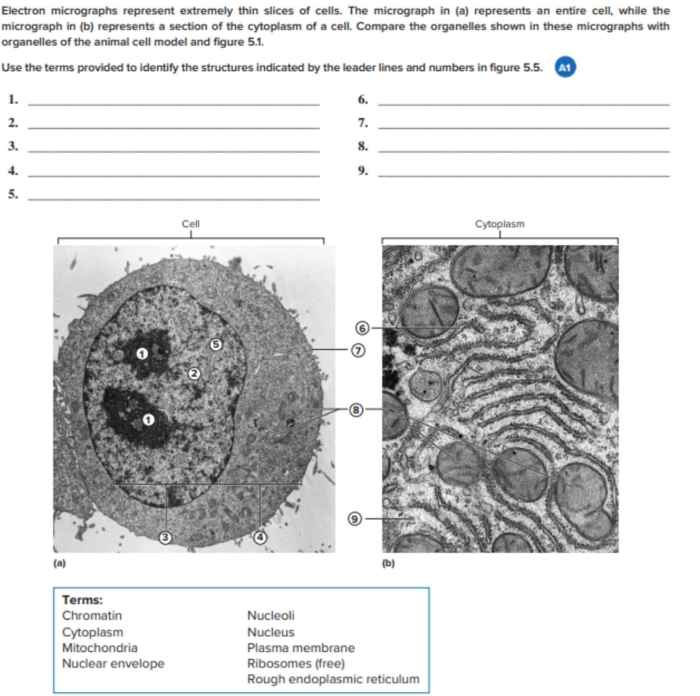Electron micrographs represent extremely thin slices, opening up a realm of unparalleled imaging capabilities. This innovative technique allows scientists to delve into the intricate details of materials, cells, and biological structures, revealing insights that were once beyond our reach. Electron microscopy has revolutionized various fields, including biology, materials science, and nanotechnology, providing invaluable information for research and development.
The process of preparing extremely thin slices for electron microscopy requires specialized equipment and expertise. These slices, typically ranging from 50 to 100 nanometers in thickness, are essential for obtaining high-resolution images. The preparation involves embedding the sample in a resin, slicing it into ultrathin sections using a diamond knife, and staining the sections to enhance contrast.
Electron Micrographs: Electron Micrographs Represent Extremely Thin Slices
Electron micrographs are images produced by electron microscopy, a technique that uses a beam of electrons to create magnified images of a specimen. Electron microscopy offers significantly higher resolution than traditional light microscopy, enabling scientists to visualize structures at the atomic and molecular level.
Preparing Extremely Thin Slices for Electron Microscopy
Preparing extremely thin slices for electron microscopy is a crucial step in the process. The specimen is embedded in a resin and cut into ultrathin sections using a diamond knife. These sections are then placed on a support grid for examination under an electron microscope.
Applications of Electron Micrographs

Electron micrographs find applications in various fields, including biology, materials science, and nanotechnology.
Biology
- Studying the ultrastructure of cells and organelles
- Investigating the molecular basis of diseases
- Characterizing microorganisms
Materials Science
- Analyzing the microstructure of materials
- Determining the composition and properties of materials
- Developing new materials with enhanced properties
Nanotechnology
- Characterizing the structure and properties of nanomaterials
- Developing novel nanodevices
- Investigating the interactions between nanomaterials and biological systems
Electron micrographs provide detailed information that is often inaccessible through other imaging techniques. However, they also have limitations, such as potential damage to the specimen and the requirement for specialized equipment and expertise.
Technical Considerations

Different types of electron microscopes are used to obtain electron micrographs, including transmission electron microscopes (TEMs) and scanning electron microscopes (SEMs).
TEMs transmit a beam of electrons through the specimen, providing high-resolution images of internal structures. SEMs scan the surface of the specimen with a beam of electrons, creating three-dimensional images.
The resolution and quality of electron micrographs are affected by factors such as the accelerating voltage, beam current, and specimen thickness.
Data Analysis and Interpretation

Analyzing and interpreting electron micrographs require specialized knowledge and software tools.
Image processing techniques are used to enhance the contrast and clarity of the images. Quantitative analysis methods allow researchers to measure and quantify structural features.
Software packages such as ImageJ and Fiji are widely used for image processing and analysis.
Emerging Advancements

Electron microscopy techniques continue to advance, enabling scientists to obtain even higher resolution and detailed images.
Cryo-Electron Microscopy (Cryo-EM)
Cryo-EM involves freezing the specimen in a thin layer of ice, preserving its native structure. This technique has revolutionized structural biology, allowing researchers to visualize the three-dimensional structures of proteins and macromolecules.
Electron Tomography, Electron micrographs represent extremely thin slices
Electron tomography involves acquiring a series of electron micrographs at different tilt angles. These images are then reconstructed to create a three-dimensional model of the specimen. This technique provides insights into the internal architecture of cells and materials.
Ethical Considerations
The use of electron micrographs raises ethical considerations related to privacy and data sharing.
Researchers must ensure that images are used responsibly and with the consent of individuals involved. Data sharing agreements and guidelines should be established to prevent unauthorized use and protect the privacy of subjects.
Top FAQs
What are the advantages of electron micrographs over other imaging techniques?
Electron micrographs offer higher resolution and magnification than other techniques, allowing for detailed visualization of ultrastructures.
What are the limitations of electron micrographs?
Electron microscopy requires specialized equipment and expertise, and the preparation of thin sections can be time-consuming and challenging.
What are some applications of electron micrographs?
Electron micrographs are used in a wide range of fields, including biology, materials science, and nanotechnology, for studying cell structures, material properties, and the behavior of nanomaterials.